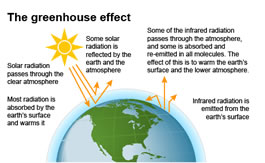Did you know?
If there were no naturally occurring greenhouse gases, the earth would be too cold to support life as we know it. Without the greenhouse effect, the average temperature of the earth would be about -2°F rather than the 57°F we currently experience.
Many of the chemical compounds in the earth’s atmosphere act as greenhouse gases. When sunlight strikes the earth’s surface, some of it radiates back toward space as infrared radiation (heat). Greenhouse gases absorb this infrared radiation and trap its heat in the atmosphere, creating a greenhouse effect that results in global warming and climate change.
Many gases exhibit these greenhouse properties. Some gases occur naturally and are also produced by human activities. Some, such as industrial gases, are exclusively human made.
What are the types of greenhouse gases?




